Legend of Tsuba-Tsuba (part of 2)
Under the head hoe.
The lark sings.
Issa
Hoe, of course, easier and cheaper than a sword. But the principle is the same: the working part can be replaced with a handle, the handle can be replaced with a working part. It's comfortable. Therefore, the Japanese mount on the blade, too, were removable. Broken blade - you can save the mount. Saving! The tsuba went out of fashion, the tsuki braid worn away - the hilt - ordered new ones. That is, the old blade could be under the requirement of a changed fashion, although the blade itself remained unchanged! At the same time, in various epochs, many varieties of sword frames were known, many of which were even regulated by the decrees of the shogun himself. But it should be remembered that all the swords of samurai of the Heian epoch and subsequent epochs, up to the Muromachi epoch, were horsemen’s swords - that is, tati swords that were worn on the thigh with a blade downwards, to the left on the belt on the cords. Cords (belts or chains) were usually two. Well, the look of the frame spoke about the status of a samurai. So, the commander usually had a rimmed sword of a sirizaya-no-tati, which differed from the others in that in this case the sword sheath was covered by two-thirds with the skin of a tiger or a boar and resembled a bushy tail! In any case, tati were worn in tandem with the tanto dagger. But the sword was opposite to the katana, they were worn tucked behind the fabric belt and paired with a wakizashi sword. Mount "without cords" was called buke-zukuri.
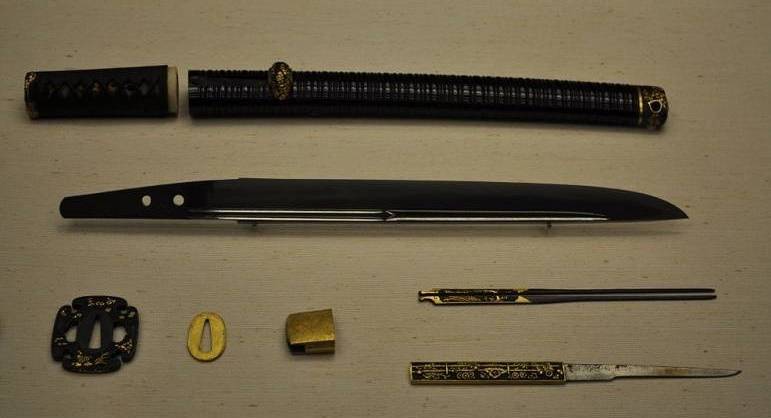
Dagger tanto disassembled. Blade with a long dol - kuitigai-hee. From left to right: tsuba, seppa, habaki, vari-kogai - kogai divided in the middle, and a “knife” of a co-gatan. (British Museum, London)
Consider the details of what was the frame of the sword Buke-zukuri:
• First of all, it was a wooden handle, which used stingray leather as a cover. Usually, she was woven around with cords of leather, silk, or cotton yarn. Tanto braid was rare.
• The handle had a “head” (kasir) and a ring with which it was attached to the handle (futi).
• The handle also had jewelery (manuki) in the form of small figures that were inserted under the braid of the handle and held by it. If it was not, then they were fixed on the handle without braid, using small pins.
• Tsuba (here we finally reached it!). Garda But "guard" in this case is a European concept, not a Japanese one. Garda is a means of protection, but here everything is quite the opposite - it is an emphasis for the hand, so that it cannot slip onto the blade under certain blows.
• The scabbard of a sword (sai) in Japan was made from magnolia wood, although ivory sheath is also known). They were varnished and decorated with paintings and inlays. Moreover, the sheaths of Japanese swords differed from European ones in that they had special “containers” where three objects were placed, unknown to Europeans. In this case, we emphasize that these "items" were included in the kit only katana sword. Tati, had no additions in the sheath. So, what were these "items"?
• Additional knife (co-gatana). He had a very artistic handle (Kozuka). A number of sources indicate that this is a throwing "knife", something like a shuriken. But ... today it is believed that in fact this knife with a blade of a characteristic shape was something like a penknife and nothing more. And for this knife in the sheath of the katana, a longitudinal “pocket” was arranged, from which only the beautiful grip of the gatana was visible, and it passed through a special hole in the tsube and went further to the sword's hilt. Located this "knife" is always on the inside of the scabbard - the side of cheers. At the same time, the handle of the ko-gatana is kozuka, usually had 10 cm long, wide 1,3 cm and in itself represented a small work of art. Again, it is interesting that it was decorated only on one side - the outside. The interior was flat and only polished. Though on it the signature of the master could be placed.
• Then it was a pin (claw), which served for various purposes: it could be used to put hair and clean ears (for this there was a special “spoon” at the end), and ... stick the killed enemy into the severed head as a sign of warning, because she, too, was framed in the same style with the accessories of the sword! It was located on the front side of the scabbard (omote). It is believed that the sheath in the sheath of a sword or dagger is a thing more ancient than the co-goman.
• Kogai could be split in the middle. In this case, he turned into vari-kogai or vari-basi — chopsticks; but not wooden, but metal; outwardly, they are similar to kogai, but only divided along.
• If the sword had a rim made in the province of Higo (this also applies to daggers), then it could have a so-called “horse needle” (dumbari), which looked like a triangular blade with a flat handle, which served as a lancet for bleeding horses.
• Kogai, ko-gatana and two manuki for decoration of the handle were special sets of mitocoro-mono (“three things”), which, together with such details as futi — an oval-shaped coupling on the handle of a tsuba, and kasir — the top of the handle, were a welcome gift from one daimyo to another. And gifts with a hint, because in their design, they could not coincide with the existing frame on the sword of the donee. And that had to happen, especially if it was a gift from the highest to the lowest, then to look for the master, so that he would complete the same tsub for them out of respect for the donor. After all, a noble donor could then ask to show a sword, or simply even see where his gifts went, and not using them meant disrespect!
We will begin our acquaintance with tsubas with tsub ... not having openings for the accessories that we are talking about here. That is, there were such swords, which had tsuba without holes - these are primarily tati and nodati (“very large tati”), but there were also katana swords, which also had no holes. Do not think that if there are no holes, then this tsuba is more ancient than the one with holes ... For example, an exceptionally simple tsuba without additional holes on it. There is only one - for the blade. This tsuba was made in the 16th century. Material: iron and copper. 8,9 thickness cm; thickness 0,6 cm; 147,4 weight, (Metropolitan Museum, New York)
All the handles of these accessories protrude from the scabbard in such a way that they pass through the holes in the cube. It is known that in the late Middle Ages in Europe, sheaths of swords happened to be attached with additional cases with accessories. These included knives, forks, and even spoons, which were especially common in so-called “hunting swords” headsets. So there is some similarity here, although there could hardly have been any connection here.
Tsuba 1615 – 1868 Obverse. Material: iron and copper. Diameter 8,6 cm; 8,3 width cm; thickness 0,5 cm; 155,9 g. Pay attention to the minimalist nature of the image. It is difficult to even understand where the obverse and where the reverse. (Metropolitan Museum, New York)
The same tsuba. Reverse.
The entire rim of the sword is called kosirae and the presence of additional “tools” in it, like cogs, co-gatanas, and a variety, significantly complicates the wizard's work. After all, the design of the scabbard of the sword also becomes more difficult. It is necessary to cut two holes in them for the arms of co-gatanas and claws. It is necessary to make them so that they enter through them into their “nests” at an angle and protrude slightly through the holes in the tsubs. And you need to make sure that they do not fall out of the channels in which they are located, while the sheath itself does not lose its strength. In addition, all these details should not be positioned in any way, but so that the co-gatan and someone can be easily removed with one movement of the thumb lying on the hilt of the sword!
This tsuba can be called the “Dzhunkui against the demon”, and yes, indeed, on it we see how the “yellow demon” turns to flee from the mere look of this bearded person in the official's headdress. Zhongkui - the tamer of demons in the popular beliefs of China, He enjoyed particular popularity in the era of the Tokugawa shogunate, which, by the way, is also reflected in the time of manufacturing this tsuba. The tsuba itself is iron, but the figure of the “yellow demon” is clearly made of bronze, and the eyes, teeth and bracelets, traditionally gold. But the image Dzhunkuya not patinated and therefore retained the natural color of red copper. Production time: 1615 – 1868 Material: iron, copper, bronze, gold. Diameter 9,2 cm; 8,9 ccm width; thickness 0,6 cm; 195.6 weight, (Metropolitan Museum, New York)
The same tsuba. Reverse. On it, the demon covered himself with a rice dish.
Thus, we see that the Japanese sword was both very simple and at the same time very complex and thoughtful product. The blade could be easily released from the rim and stored for a long time in a special case, again providing a special frame for storage. It was possible to order any number of frames, made in the same style with armor or ceremonial clothing, to the same blade. Not to mention that the design of the rim of the swords was regulated by numerous decrees of the shoguns. For example, by decree of 1624, the red sheath and square tsuba were forbidden, as well as blades longer than 60. See as desired by his master. It was envisaged that, when posing as a shogun, a samurai should have not only special Nagabakam pants with long trousers like a train so that the owner could not commit a treacherous attack, but he also had a special sword with him — kamisimo dzasi. This short sword did not have guards, and the handle had makugi, so that it easily slid off the blade when trying to snatch it from its belt. Well, and the servant standing at the door, carefully checked who with what is included in the rooms of their master and whether there is or no mekugi in the hilt of their sword!
Tsuba "Samurai for the tree." It depicts a samurai in a straw cloak, standing or hiding behind a flowering tree (obverse), but he dropped his hat on the reverse side of the tsuba, that is, the one that faces the edge of the blade. There are no holes for it and co-gatanas. But note: there are two small holes in it. What is it and why? These openings were called udenuki-ana, and served to pass through the lanyard cord. Not all tsubah they were, but ... they were. Production time: XVIII century. Material: iron, gold, silver, copper, bronze. Diameter 7,9 cm; 7,5 width cm; thickness 0,8 cm; 175,8 weight, (Metropolitan Museum, New York)
The same tsuba. Reverse.
Decrees were also issued to combat luxury. So, in 1830, it was forbidden to have a frame with details of gold on swords. But the samurai immediately found a way out and everything that was made of gold was ordered to paint over with black varnish - an extra example of the fact that any prohibitions, in general, is completely and easily circumvented.
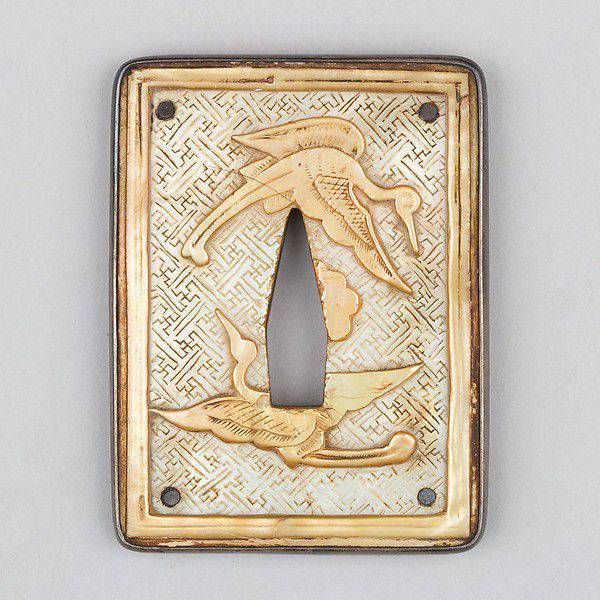
Many consider and even write about it in books, referring to the collections of their friends and acquaintances that the Japanese did not use materials such as stone, corals, mother-of-pearl, pearls for the decoration of the cube, although even materials such as wood, leather, ivory and porcelain. Actually used, but rarely. And here is one of such rare tsub. Production time: 1615 - 1868. Material: copper and nacre. Weight 85 (Metropolitan Museum, New York)
To be continued ...
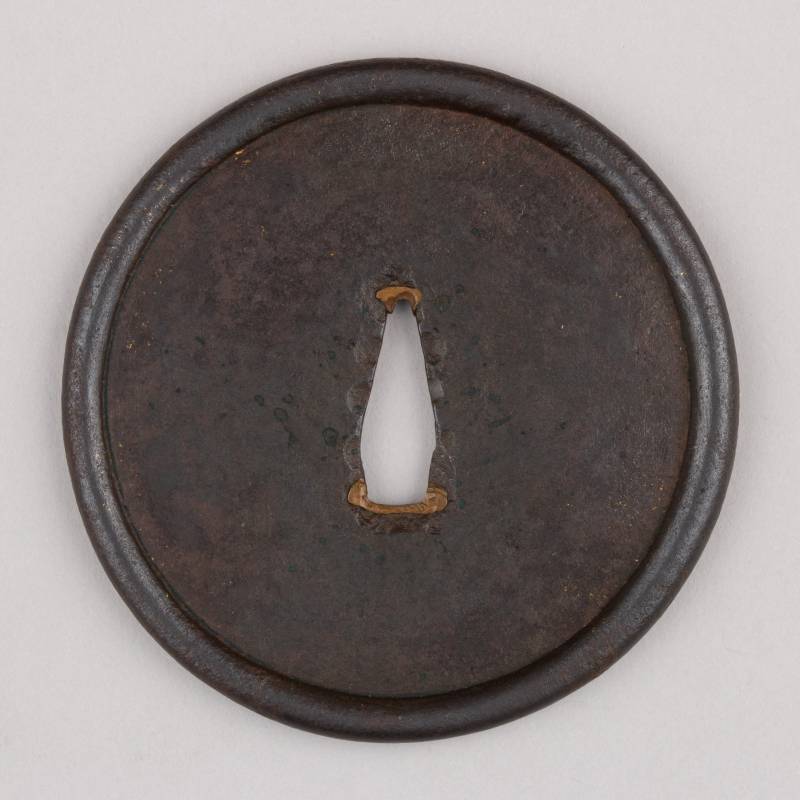
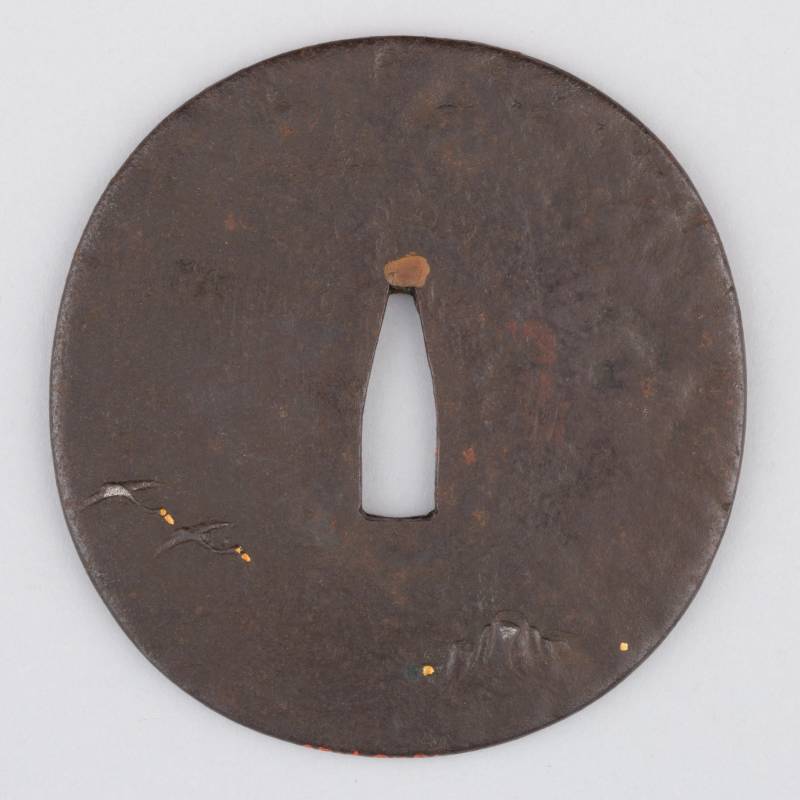
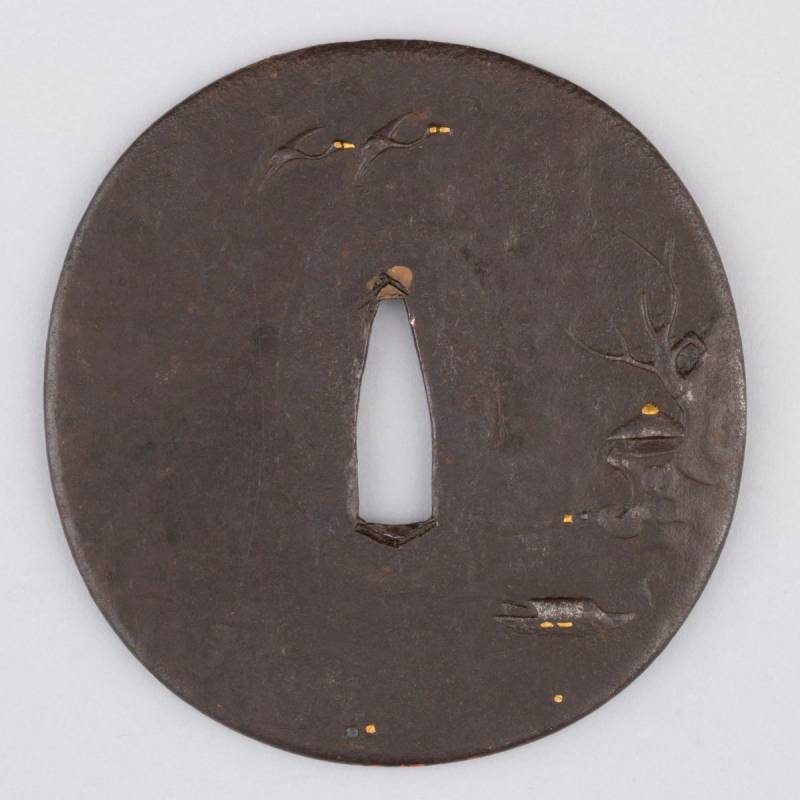
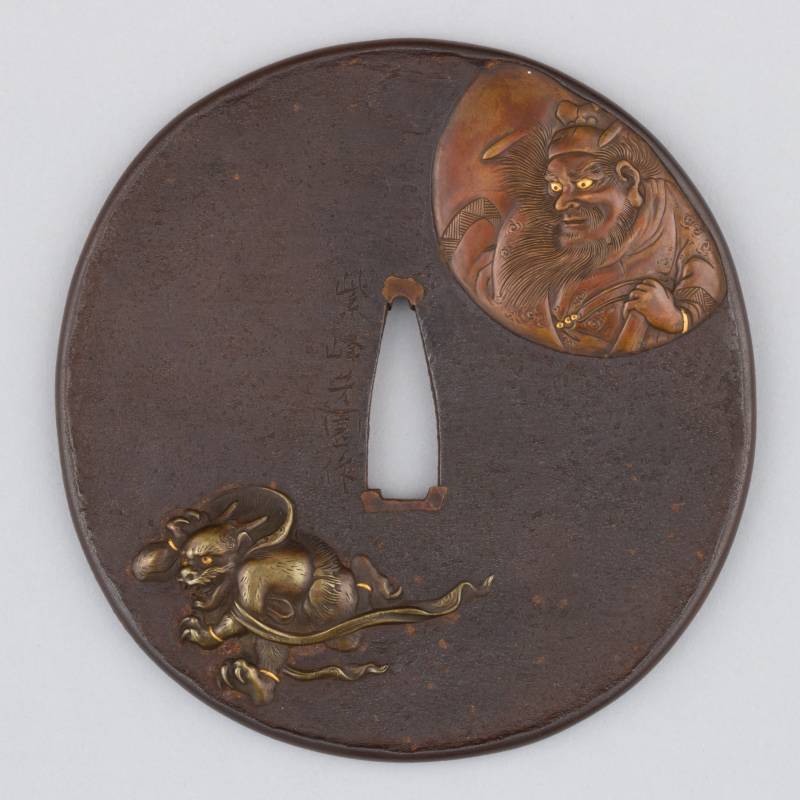
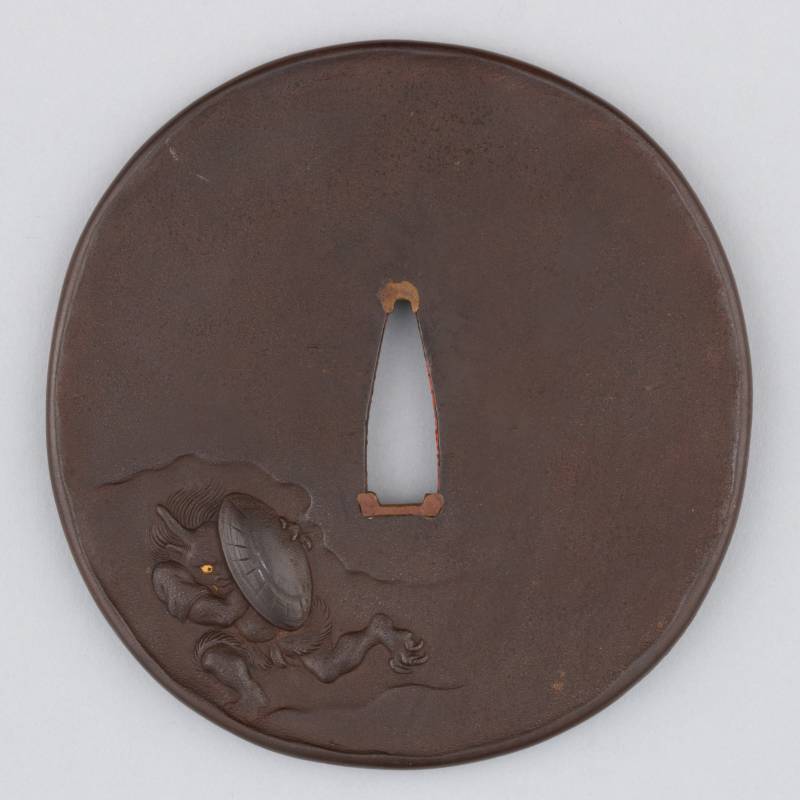
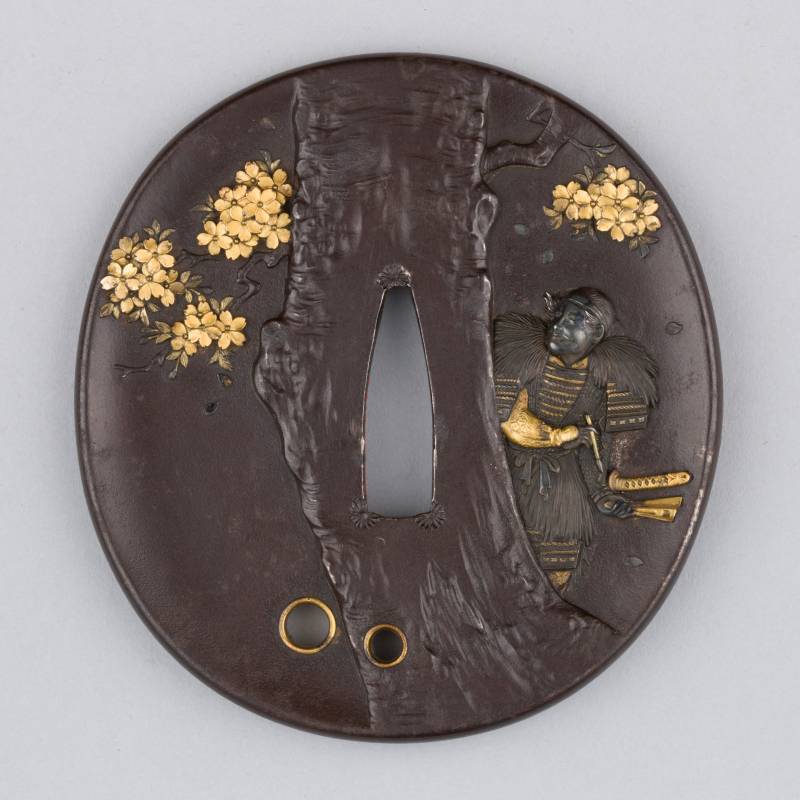
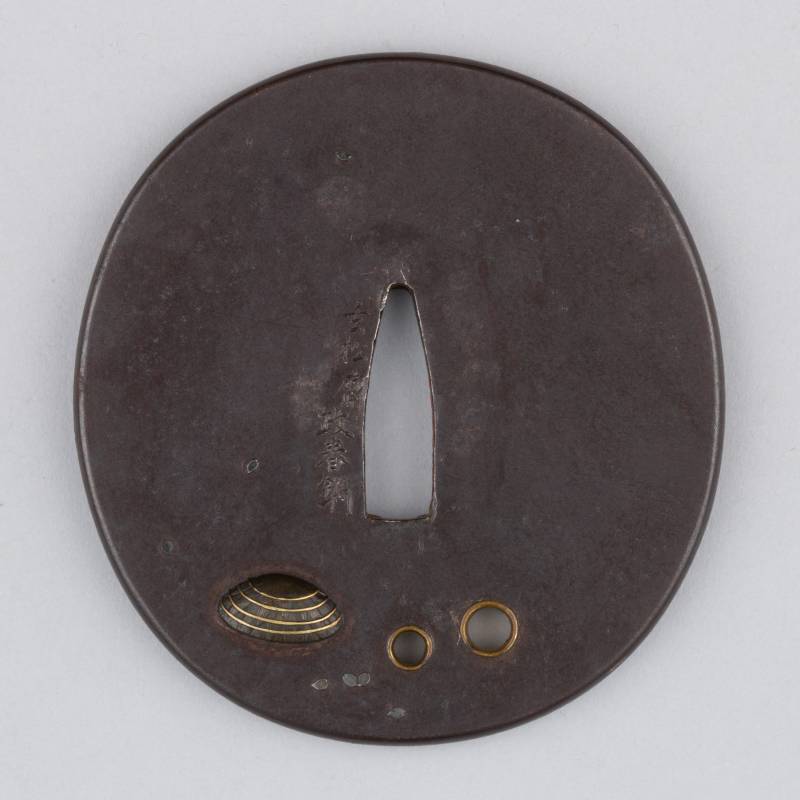
Information